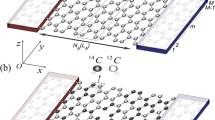Abstract
Pristine graphene has low thermoelectric performance due to its ultra-high thermal conductivity and a low Seebeck coefficient, the latter of which results from the zero-band gap of graphene. To improve the thermoelectric performance of graphene-based materials, various methods have been proposed to open a band gap in graphene. Graphene antidot lattices is one of the most effective methods to reach this goal by patterning periodic nano- or sub-1-nm pores (antidots) across graphene. In high-porosity graphene antidot lattices, charge carriers mainly flow through the narrow necks between pores, forming a comparable case as graphene nanoribbons. This will open a geometry-dependent band gap and dramatically increase the Seebeck coefficient. The antidots also strongly scatter phonons, leading to a dramatically reduced lattice thermal conductivity to further enhance the thermoelectric performance. In computations, the thermoelectric figure of merit of a graphene antidot lattices was predicted to be around 1.0 at 300 K but experimental validation is still required. The electrical conductivity and Seebeck coefficient of graphene antidot lattices on various substrates including SiO2, SiC and hexagonal boron nitride were measured. The antidots were drilled with a focused ion beam or reactive ion etching.
Similar content being viewed by others
References
H. J. Goldsmid, Thermoelectric Refrigeration. (Plenum, New York, 1964).
J. Yang and F. R. Stabler, Journal of Electronic Materials 38 (7), 1245–1251 (2009).
D. Kraemer, B. Poudel, H. P. Feng, J. C. Caylor, B. Yu, X. Yan, Y. Ma, X. Wang, D. Wang, A. Muto, K. McEnaney, M. Chiesa, Z. Ren and G. Chen, Nature Materials 10 (7), 532–538 (2011).
K. S. Novoselov, A. K. Geim, S. Morozov, D. Jiang, Y. Zhang, S. Dubonos, I. Grigorieva and A. Firsov, Science 306 (5696), 666–669 (2004).
K. Novoselov, A. K. Geim, S. Morozov, D. Jiang, M. K. I. Grigorieva, S. Dubonos and A. Firsov, Nature 438 (7065), 197–200 (2005).
D. Jariwala, A. Srivastava and P. M. Ajayan, Journal of Nanoscience and Nanotechnology 11 (8), 6621–6641 (2011).
Y. Yan, Q.-F. Liang, H. Zhao, C.-Q. Wu and B. Li, Physics Letters A 376 (35), 2425–2429 (2012).
H. Karamitaheri, M. Pourfath, R. Faez and H. Kosina, Journal of Applied Physics 110 (5), 054506 (2011).
T. Gunst, T. Markussen, A.-P. Jauho and M. Brandbyge, Physical Review B 84 (15), 155449 (2011).
T. Gunst, L. Jing-Tao, T. Markussen, A. Jauho and M. Brandbyge, presented at the 2012 15th International Workshop on Computational Electronics (IWCE), Madison, USA, 2012 (unpublished).
D. Wu, Z. Yu, J. Xiao and F. Ouyang, Physica E: Low-dimensional Systems and Nanostructures 43 (1), 33–39 (2010).
H. Zhang, Z.-X. Guo, W. Zhao, X. Gong and J. Cao, Journal of the Physical Society of Japan 81 (11), 114601 (2012).
J. Robillard, K. Muralidharan, J. Bucay, P. Deymier, W. Beck and D. Barker, Chinese Journal of Physics 49, 448–461 (2011).
K. L. Grosse, M.-H. Bae, F. Lian, E. Pop and W. P. King, Nature Nanotechnology 6 (5), 287–290 (2011).
J. Oh, H. Yoo, J. Choi, J. Y. Kim, D. S. Lee, M. J. Kim, J.-C. Lee, W. N. Kim, J. C. Grossman, J. H. Park, S.-S. Lee, H. Kim and J. G. Son, Nano Energy 35, 26–35 (2017).
W. Zhu, T. Low, V. Perebeinos, A. A. Bol, Y. Zhu, H. Yan, J. Tersoff and P. Avouris, Nano Letters 12 (7), 3431–3436 (2012).
A. Sandner, T. Preis, C. Schell, P. Giudici, K. Watanabe, T. Taniguchi, D. Weiss and J. Eroms, Nano Letters 15 (12), 8402–8406 (2015).
R. Yagi, R. Sakakibara, R. Ebisuoka, J. Onishi, K. Watanabe, T. Taniguchi and Y. Iye, Physical Review B 92 (19), 195406 (2015).
H. J. Goldsmid, Introduction to Thermoelectricity. (Springer, Berlin, 2010).
Author information
Authors and Affiliations
Rights and permissions
About this article
Cite this article
Hao, Q., Xu, D., Ruden, X. et al. Thermoelectric Performance Study of Graphene Antidot Lattices on Different Substrates. MRS Advances 2, 3645–3650 (2017). https://doi.org/10.1557/adv.2017.509
Published:
Issue Date:
DOI: https://doi.org/10.1557/adv.2017.509




